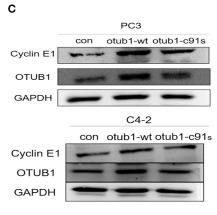OTUB1 Antibody - #DF9998
| Product: | OTUB1 Antibody |
| Catalog: | DF9998 |
| Description: | Rabbit polyclonal antibody to OTUB1 |
| Application: | WB IHC IF/ICC |
| Reactivity: | Human, Mouse, Rat |
| Prediction: | Pig, Bovine, Horse, Sheep, Dog, Chicken |
| Mol.Wt.: | 31 kDa; 31kD(Calculated). |
| Uniprot: | Q96FW1 |
| RRID: | AB_2843190 |
Related Downloads
Protocols
Product Info
*The optimal dilutions should be determined by the end user.
*Tips:
WB: For western blot detection of denatured protein samples. IHC: For immunohistochemical detection of paraffin sections (IHC-p) or frozen sections (IHC-f) of tissue samples. IF/ICC: For immunofluorescence detection of cell samples. ELISA(peptide): For ELISA detection of antigenic peptide.
Cite Format: Affinity Biosciences Cat# DF9998, RRID:AB_2843190.
Fold/Unfold
Deubiquitinating enzyme OTUB1; hOTU1; HSPC263; OTB1; OTU domain containing ubiquitin aldehyde binding protein 1; OTU domain, ubiquitin aldehyde binding 1; OTU domain-containing Ubal-binding protein 1; OTU domain-containing ubiquitin aldehyde-binding protein 1; OTU-domain Ubal-binding 1; OTU1; Otub1; OTUB1_HUMAN; Otubain 1; Otubain-1; Ubiquitin specific processing protease OTUB1; Ubiquitin thioesterase OTUB1; ubiquitin-specific protease otubain 1; Ubiquitin-specific-processing protease OTUB1;
Immunogens
Isoform 1 is ubiquitous. Isoform 2 is expressed only in lymphoid tissues such as tonsils, lymph nodes and spleen, as well as peripheral blood mononuclear cells.
- Q96FW1 OTUB1_HUMAN:
- Protein BLAST With
- NCBI/
- ExPASy/
- Uniprot
MAAEEPQQQKQEPLGSDSEGVNCLAYDEAIMAQQDRIQQEIAVQNPLVSERLELSVLYKEYAEDDNIYQQKIKDLHKKYSYIRKTRPDGNCFYRAFGFSHLEALLDDSKELQRFKAVSAKSKEDLVSQGFTEFTIEDFHNTFMDLIEQVEKQTSVADLLASFNDQSTSDYLVVYLRLLTSGYLQRESKFFEHFIEGGRTVKEFCQQEVEPMCKESDHIHIIALAQALSVSIQVEYMDRGEGGTTNPHIFPEGSEPKVYLLYRPGHYDILYK
Predictions
Score>80(red) has high confidence and is suggested to be used for WB detection. *The prediction model is mainly based on the alignment of immunogen sequences, the results are for reference only, not as the basis of quality assurance.
High(score>80) Medium(80>score>50) Low(score<50) No confidence
PTMs - Q96FW1 As Substrate
| Site | PTM Type | Enzyme | Source |
|---|---|---|---|
| A2 | Acetylation | Uniprot | |
| S16 | Phosphorylation | P68400 (CSNK2A1) | Uniprot |
| S18 | Phosphorylation | P36897 (TGFBR1) | Uniprot |
| Y26 | Phosphorylation | Uniprot | |
| S55 | Phosphorylation | Uniprot | |
| K59 | Ubiquitination | Uniprot | |
| Y68 | Phosphorylation | Uniprot | |
| K71 | Ubiquitination | Uniprot | |
| K73 | Ubiquitination | Uniprot | |
| K84 | Ubiquitination | Uniprot | |
| C91 | S-Nitrosylation | Uniprot | |
| S108 | Phosphorylation | Uniprot | |
| K109 | Ubiquitination | Uniprot | |
| S161 | Phosphorylation | Uniprot | |
| Y174 | Phosphorylation | Uniprot | |
| K188 | Acetylation | Uniprot | |
| K188 | Sumoylation | Uniprot | |
| K188 | Ubiquitination | Uniprot | |
| K201 | Ubiquitination | Uniprot |
Research Backgrounds
Hydrolase that can specifically remove 'Lys-48'-linked conjugated ubiquitin from proteins and plays an important regulatory role at the level of protein turnover by preventing degradation. Regulator of T-cell anergy, a phenomenon that occurs when T-cells are rendered unresponsive to antigen rechallenge and no longer respond to their cognate antigen. Acts via its interaction with RNF128/GRAIL, a crucial inductor of CD4 T-cell anergy. Isoform 1 destabilizes RNF128, leading to prevent anergy. In contrast, isoform 2 stabilizes RNF128 and promotes anergy. Surprisingly, it regulates RNF128-mediated ubiquitination, but does not deubiquitinate polyubiquitinated RNF128. Deubiquitinates estrogen receptor alpha (ESR1). Mediates deubiquitination of 'Lys-48'-linked polyubiquitin chains, but not 'Lys-63'-linked polyubiquitin chains. Not able to cleave di-ubiquitin. Also capable of removing NEDD8 from NEDD8 conjugates, but with a much lower preference compared to 'Lys-48'-linked ubiquitin.
Plays a key non-catalytic role in DNA repair regulation by inhibiting activity of RNF168, an E3 ubiquitin-protein ligase that promotes accumulation of 'Lys-63'-linked histone H2A and H2AX at DNA damage sites. Inhibits RNF168 independently of ubiquitin thioesterase activity by binding and inhibiting UBE2N/UBC13, the E2 partner of RNF168, thereby limiting spreading of 'Lys-63'-linked histone H2A and H2AX marks. Inhibition occurs by binding to free ubiquitin: free ubiquitin acts as an allosteric regulator that increases affinity for UBE2N/UBC13 and disrupts interaction with UBE2V1. The OTUB1-UBE2N/UBC13-free ubiquitin complex adopts a configuration that mimics a cleaved 'Lys48'-linked di-ubiquitin chain.
Cytoplasm.
Isoform 1 is ubiquitous. Isoform 2 is expressed only in lymphoid tissues such as tonsils, lymph nodes and spleen, as well as peripheral blood mononuclear cells.
Isoform 1 and isoform 2 interact with RNF128. Isoform 1 forms a ternary complex with RNF128 and USP8. Isoform 1 interacts with the C-terminal UCH catalytic domain of USP8. Isoform 2 does not associate with USP8. Interacts with FUS, ESR1 and RACK1. Interacts with UBE2N/UBC13.
In addition to ubiquitin-binding at the Cys-91 active site, a proximal ubiquitin-binding site is also present at Cys-23 Occupancy of the active site is needed to enable tight binding to the second site. Distinct binding sites for the ubiquitins may allow to discriminate among different isopeptide linkages (i.e. 'Lys-48'-, 'Lys-63'-linked polyubiquitin) in polyubiquitin substrates and achieve linkage-specific deubiquitination.
Belongs to the peptidase C65 family.
References
Application: WB Species: Mice Sample: PC3 and C4-2 cells
Application: IHC Species: Mice Sample: tumors
Restrictive clause
Affinity Biosciences tests all products strictly. Citations are provided as a resource for additional applications that have not been validated by Affinity Biosciences. Please choose the appropriate format for each application and consult Materials and Methods sections for additional details about the use of any product in these publications.
For Research Use Only.
Not for use in diagnostic or therapeutic procedures. Not for resale. Not for distribution without written consent. Affinity Biosciences will not be held responsible for patent infringement or other violations that may occur with the use of our products. Affinity Biosciences, Affinity Biosciences Logo and all other trademarks are the property of Affinity Biosciences LTD.


